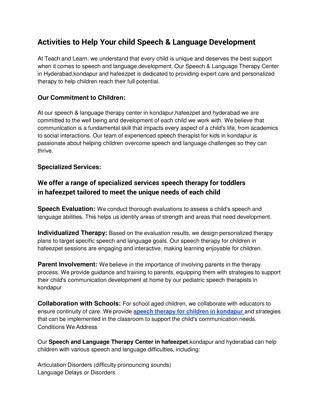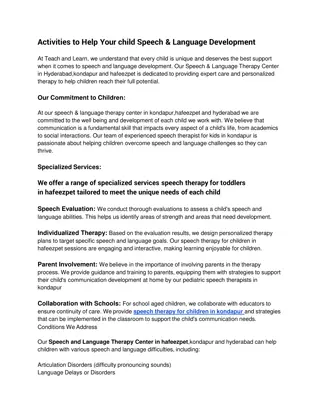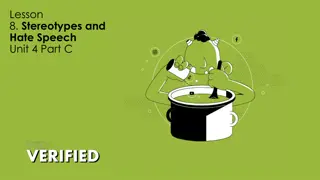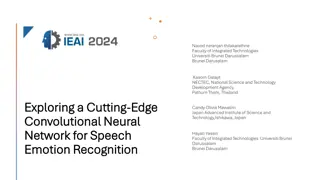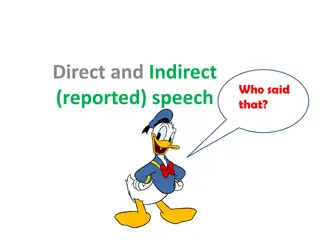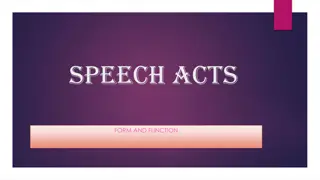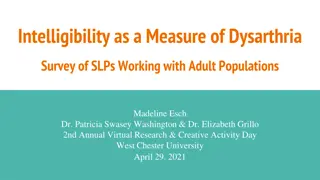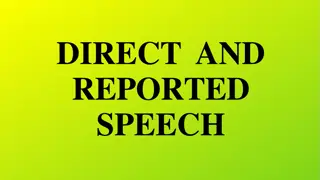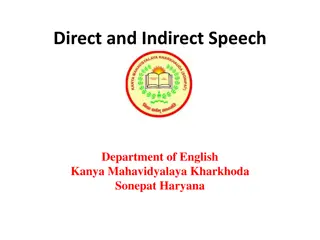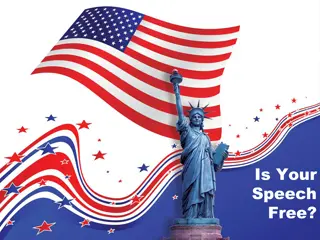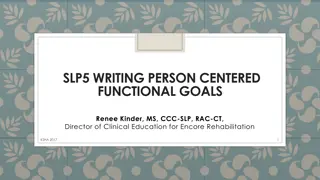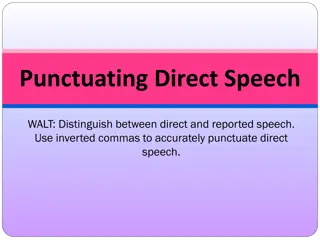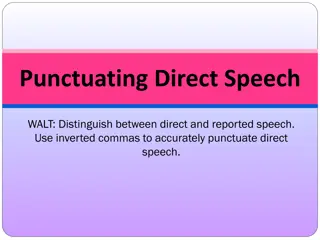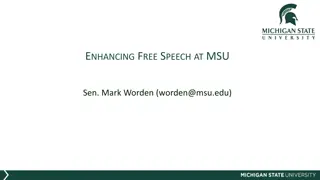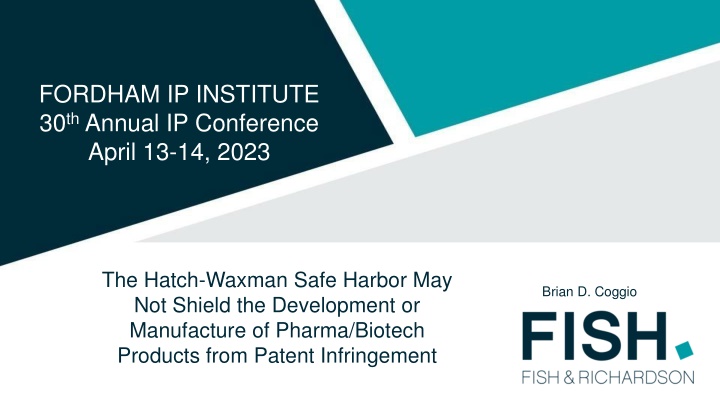
The Hatch-Waxman Safe Harbor in Pharma and Biotech Industries
Delve into the implications of the Hatch-Waxman safe harbor provision under 35 U.S.C. 271(e)(1) for pharmaceutical and biotechnology companies conducting research and development. Explore how this safeguard impacts patent infringement concerns and the development of new products. Learn about the protection it offers and its limitations in the United States.
Download Presentation

Please find below an Image/Link to download the presentation.
The content on the website is provided AS IS for your information and personal use only. It may not be sold, licensed, or shared on other websites without obtaining consent from the author. If you encounter any issues during the download, it is possible that the publisher has removed the file from their server.
You are allowed to download the files provided on this website for personal or commercial use, subject to the condition that they are used lawfully. All files are the property of their respective owners.
The content on the website is provided AS IS for your information and personal use only. It may not be sold, licensed, or shared on other websites without obtaining consent from the author.
E N D
Presentation Transcript
FORDHAM IP INSTITUTE 30th Annual IP Conference April 13-14, 2023 The Hatch-Waxman Safe Harbor May Not Shield the Development or Manufacture of Pharma/Biotech Products from Patent Infringement Brian D. Coggio
The Hatch-Waxman Safe Harbor The Hatch-Waxman safe harbor, 35 U.S.C. 271(e)(1), was enacted to allow pharma/biotech companies to conduct research and development needed to obtain FDA approval of their products without concerns of patent infringement This also allowed time to resolve any patent disputes before FDA approval and subsequent market introduction. This head-start allowed generic (biosimilars) and branded (biologics) products to get to market more quickly. Unlike the EU and GB, the United States does not have a research exemption that shields basic research, i.e., research/development directed to ascertaining new knowledge about a pharma/biotech product or process, from patent infringement. Thus, the only protection for such conduct in the United States is the Hatch-Waxman safe harbor. fr.com | 2
The Hatch-Waxman Safe Harbor PATENT INFRINGEMENT - 35 U.S.C. 271(a) (a) Except as otherwise provided in this title, whoever without authority makes, uses, offers to sell, or sells any patented invention, within the United States or imports into the United States any patented invention during the term of the patent therefore, infringes the patent . . . SAFE HARBOR - 35 U.S.C. 271(e)(1) (e) (1) It shall not be an act of infringement to make, use, offer to sell, or sell within the United States or import into the United States a patented invention (other than a new animal drug or veterinary biological product (as those terms are used in the Federal Food, Drug, and Cosmetic Act and the Act of March 4, 1913) which is primarily manufactured using recombinant DNA, recombinant RNA, hybridoma technology, or other processes involving site specific genetic manipulation techniques) solely for uses reasonably related to the development and submission of information under a Federal law which regulates the manufacture, use, or sale of drugs or veterinary biological products. Safe harbor provides a wide berth of protection , Merck KGAA v. Integra Lifesciences, 545 U.S. 193, 202 (2005), but not all otherwise infringing acts are exempt. Amgen Inc. v. International Trade Comm., 565 F.3d 846, 842 (Fed. Cir. 2009). fr.com | 3
Research Tools NIH considers research tools to encompass full range of techniques that scientists use in the laboratory Cell lines, monoclonal antibodies, reagents, chemical models, growth factors, combinatorial chemistry and DNA libraries, clones and cloning tools (such as PCR), laboratory equipment, and machines. The leading decision is Proveris Scientific Corp. v. Innovasystems Inc., 536 F.3d 1256, 1265 (Fed. Cir. 2008). An optical spray, which was not subject to FDA approval, was used to analyze the final FDA product. Federal Circuit held that safe harbor did not apply because the optical spray was not subject to FDA review and approval. Decisions post-Proveris, however, were not consistent. ComparePSN Illinois LLC v. Abbott Labs, 2011 U.S. Dist. Lexis 108055 (N.D. Ill 2011) withTeva Pharm. USA, Inc. v. Sandoz Inc., 2013 U.S. Dist. Lexis 99121 (S.D.N.Y. 2013). fr.com | 4
Recent Decisions No Protection For Research Tools In 2021, the California District Court in Allele Biotech Pharms, Inc. v. Pfizer, Inc., 2021 U.S. Dist. LEXIS 85347 (S.D. Cal. May 4, 2021), held that Pfizer s use of Allele s patented Neon Green product (a research tool) to develop its Covid vaccine infringed Allele s patent. The tool was not subject to FDA approval; thus, no safe harbor protection. Because the invention claimed in the patent at issue was not subject to a required FDA approval process, it was not a patented invention for purposes of section 271(e)(1). Id. at *8. In 2022, in Regenxbio Inc. v. Sarepta Therapeutics, Inc., 2022 U.S. Dist. LEXIS 1945 (D. Del. Jan. 4, 2002), the Delaware District Court held that Sarepta s use of Regenxbio s patented host cells to manufacture products for clinical trials infringed. The tool was not subject to FDA approval; thus, no safe harbor protection. Since the patented cells are not subject to FDA regulatory approval, they are not a patented invention under section 271(e)(1) . Id. at *7. Certification to the Federal Circuit was denied. *See Coggio and Del Dotto, Regenxbio v. Sarepta: Make Sure You re Safely Within the Safe Harbor Before Using a Research Tool, Fish Lit. Blog (Jan. 20, 2022); Coggio and Del Dotto, Users of Research Tools Take Note, Fish Lit. Blog. (June 7, 2021). fr.com | 5
Consequences All laboratory research and development activity including potential commercialization must be analyzed in view of the recent Allele and Regenxbio decisions. What damages? Little guidance in case law. But in Amgen Inc. v. Hospira, Inc., 944 F.3d 1327 (Fed. Cir. 2019), the Federal Circuit dismissed Hospira s safe harbor defense and confirmed Judge Andrew s award of $70,000,000 to Amgen. In Amgen, the patent had expired by trial, and Hospira had not (and would not) market a competing product. fr.com | 6
Thank You! Brian D. Coggio Of Counsel 7 Times Square 20th Floor New York, NY 10036 coggio@fr.com

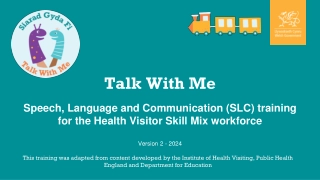
![Prevention and Combating of Hate Crimes and Hate Speech Bill [B.9B.2018]](/thumb/60513/prevention-and-combating-of-hate-crimes-and-hate-speech-bill-b-9b-2018.jpg)

